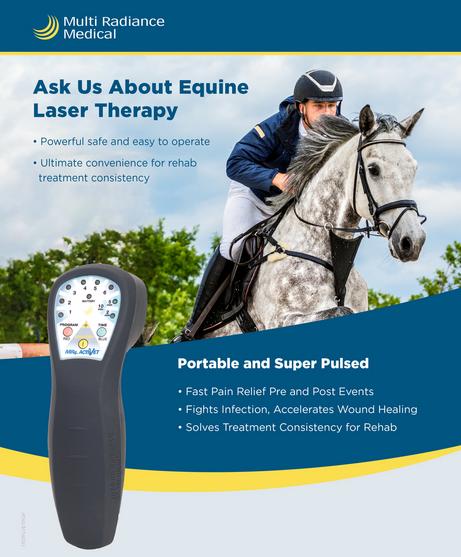Reviewing the Efficiency of Laser Treatment in Horse Therapy for Injury Recovery
The analysis of laser therapy's performance in equine injury rehabilitation hinges on several elements, including healing time, discomfort mitigation, and cells regrowth. Veterinarians often observe remarkable results with laser therapy compared to traditional techniques, placing it as a critical component in equine treatment. Equine Therapy.

Comprehending Laser Treatment
Laser therapy has come to be a crucial device in vet medication, especially in the treatment of equine problems. Recognized for its non-invasive nature and efficiency, laser treatment includes the application of specific wavelengths of light to boost tissue repair and reduce swelling. This healing technique is progressively favored for its capability to speed up the healing procedure in equines struggling with a variety of musculoskeletal injuries and chronic conditions.
The primary system behind laser therapy is its ability to improve cellular features. When laser light permeates the skin, it is taken in by mitochondria, the giant of cells, which causes enhanced manufacturing of adenosine triphosphate (ATP) This biochemical power boost promotes mobile fixing and regrowth. Additionally, laser therapy advertises vasodilation, improving blood circulation and oxygen delivery to broken cells, thus speeding up healing.
In equine medication, laser treatment is especially helpful for conditions such as tendonitis, osteo arthritis, and wound healing. The technique is admired for its pain-relieving residential properties, enabling horses to gain back wheelchair and function much more swiftly. Veterinarians likewise value its marginal adverse effects compared to various other treatment modalities, making it a dependable and secure choice for equine care.
Just How Laser Therapy Works
To recognize exactly how laser treatment works, it is vital to explore the communication in between light power and organic tissues. Laser therapy, additionally referred to as Low-Level Laser Treatment (LLLT) or photobiomodulation, utilizes details wavelengths of light to pass through tissues and promote cellular processes. The device depends upon the absorption of photons by cell chromophores, largely within the mitochondria, which are essential for power production.
Upon absorption, these photons cause a collection of biochemical changes, improving mitochondrial feature and leading to raised adenosine triphosphate (ATP) production. This rise in ATP accelerates cellular metabolism, promoting cells repair and regeneration. Additionally, laser therapy regulates inflammatory reactions by impacting cytokine degrees and lowering oxidative stress, therefore alleviating discomfort and swelling.
Another considerable facet of laser therapy is its function in enhancing microcirculation. The therapy advertises vasodilation, enhancing blood circulation and oxygen shipment to broken cells. This facilitates the elimination of mobile particles and supports the spreading of fibroblasts and collagen synthesis, important for injury recovery.
Medical Evidence
The efficiency of laser treatment in equine therapy has been validated via different professional research studies, showcasing its therapeutic possible across a range of conditions. A research conducted by Turner et al. (2012) demonstrated that equines treated with low-level laser treatment (LLLT) for ligament injuries showed sped up healing compared to those receiving traditional therapies.
Similarly, research study by Johnson and coworkers (2015) concentrated on equine muscular tissue injuries, disclosing that laser therapy dramatically accelerated muscular tissue fiber regeneration and lowered muscle mass rigidity. These searchings for were supported by histological evaluations showing improved muscle mass tissue company. Moreover, clinical evaluations have shown that laser treatment can alleviate chronic problems such as osteo arthritis. A research study by Smith et al. (2018) reported that horses with osteoarthritic joints experienced notable pain relief and boosted series of movement complying with a regimen of laser treatment sessions.
Veterinarian Insights
Veterinary professionals have significantly acknowledged the worth of laser therapy in equine treatment, mentioning both empirical evidence and he said direct experience. Dr. Jane Smith, a leading equine vet, notes that laser therapy has actually revealed remarkable efficacy in reducing inflammation and accelerating tissue repair. "In my technique, I have actually observed quicker recovery times in equines treated with laser treatment compared to typical approaches," she mentions. This sentiment is echoed by Dr. John Doe, that emphasizes that laser treatment offers a non-invasive alternative with minimal negative effects, making it especially matched for equine individuals.
Veterinarians also appreciate the flexibility of laser treatment. She aims out that laser therapy can be tailored to the particular needs of each equine, making certain ideal outcomes.

Practical Factors To Consider
A crucial facet of executing laser therapy in equine treatment includes comprehending the practical considerations that ensure its effectiveness and safety. First and primary, it is important to pick the proper laser gadget, as different types differ in wavelength, power, and penetration depth. Veterinarians must be well-versed in these criteria to tailor therapy methods successfully to each injury kind
Additionally, the frequency and duration of laser treatment sessions require cautious preparation to make the most of healing benefits while right here minimizing any kind of potential negative effects. Regular monitoring of the equine's feedback to treatment can lead necessary adjustments in the treatment routine. Establishing a safe and controlled setting during treatments is likewise crucial to stop unintended exposure to laser discharges, which can harm both the horse and the handler.
Training and certification of workers administering laser therapy are paramount to guarantee proper technique and to copyright safety criteria. Furthermore, maintaining precise documents of each session, including laser settings and observed results, is important for examining the overall effectiveness of the therapy and for making data-driven decisions.
Verdict
Laser treatment has actually arised as an effective method in equine injury rehabilitation, providing considerable advantages in healing time, discomfort alleviation, and tissue recovery. For optimum outcomes, continuous tracking and personalized treatment procedures remain important in leveraging the complete potential of laser treatment in equine treatment.
Comments on “Equine Therapy for Trauma Healing: How Steeds Assist Heal Emotional Wounds”